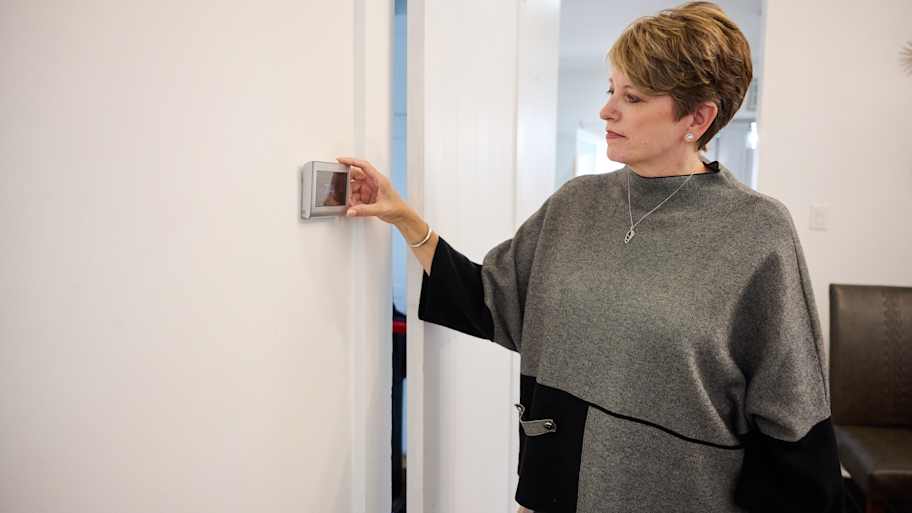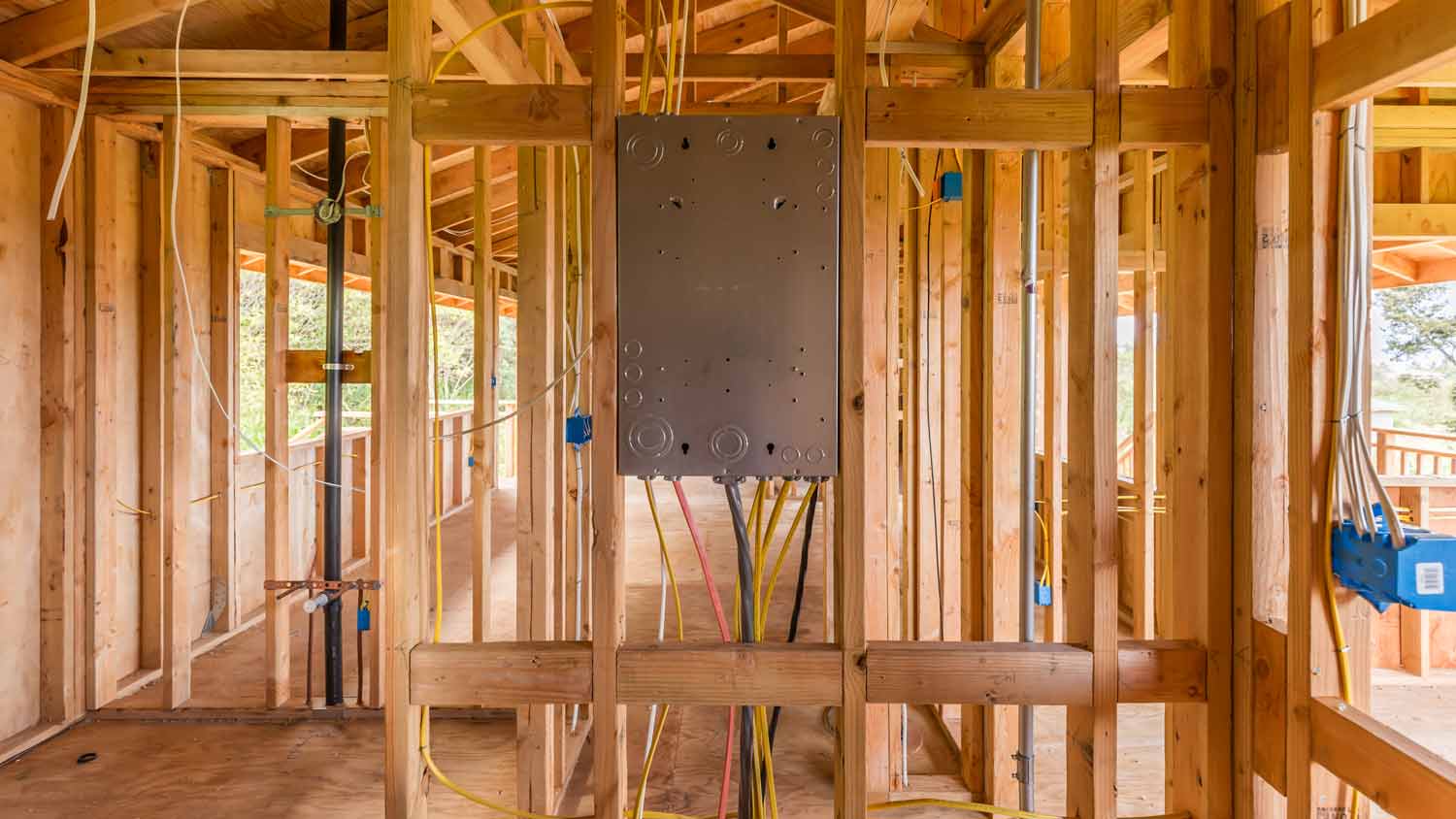How to Wire a Switch to an Outlet: 8 Steps to Success
We shed some light on how to DIY wiring a switch to an outlet


- Voltage tester
- Drill
- Wire strippers
- Screwdriver
- Needlenose pliers
- Wire nut
- Receptacle
- Single-pole switch
- Two-wire cable
If you’re tired of fumbling in the dark for the switch to your bedside lamp or just looking to add some extra functionality to your electrical outlets, wiring a switch to an outlet is the perfect solution. If you’re comfortable with DIY electrical work, it’s a relatively simple project that doesn’t always require a professional electrician—however, if you haven’t worked with electrical before, call in a pro. Here’s what you need to do to wire a switch to an outlet.
Can You Add an Off Switch to an Outlet Receptacle?
It’s possible to add an off switch to an outlet receptacle so you can control the power to it. You can complete this task by replacing your existing outlet with a switch/outlet combination, or install a separate wall switch to control the outlet.
However, consider hiring a local electrician to make changes to your home’s outlets. If you don’t have electrical experience, you’ll need to follow more detailed instructions on removing your current receptacle and installing a new switch in its place.
How to Wire a Switch to an Outlet
Again, be sure there is no power on the circuit before you begin this project. Here are the steps for wiring a switch to an outlet.
Shut Off the Power
Before you begin wiring a switch to an outlet, shut off the power to the circuit at the breaker box. Testing each plug with a voltage tester is important to ensure there is no power to the circuit. You can verify that the tester is working correctly by checking it on a known live outlet first. Always test both the hot and neutral wires, as well as the ground, to confirm that no residual electricity is present. These precautions can help prevent electrical shocks and ensure a safe working environment.
Remove the Receptacle
 Photo: photovs / iStock / Getty Images Plus / Getty Images
Photo: photovs / iStock / Getty Images Plus / Getty ImagesOnce you’ve confirmed that no electrical current is running through the wires, remove the cover plate from the existing outlet and unscrew the screws holding the outlet in place.
Once the outlet is loose, pull it out of the electrical box carefully to expose the attached wires. Be sure to inspect the wiring for any signs of wear, fraying, or damage, as faulty wiring should be replaced first. If necessary, use a voltage tester one more time to make sure that no current is present.
Cut a Hole for the Switch Box
 Photo: BanksPhotos / iStock / Getty Images Plus / Getty Images
Photo: BanksPhotos / iStock / Getty Images Plus / Getty ImagesUse a stud finder to check for wall studs or any other obstructions that could interfere with the placement of the switch box. Mark the outline of the box with a pencil to guide your cuts, then use your saw to cut a hole where you’ll put the new switch box. Be sure to put it in a spot where your cable can reach the receptacle box.
After the hole is cut, test the switch box to ensure it covers the exposed area. If necessary, trim the edges slightly for a better fit, but avoid making the hole too large, as this can make securing the box difficult.
Run the Cable From the Hole to the Receptacle Box
Now, take your cable and run it through the wall to the existing receptacle box. Once the cable reaches the box, leave enough slack to work with before securing it in place. Clamp the cable to the box so it stays put while you work. Make sure that the cable is properly positioned and not pinched or twisted, as this can cause electrical issues down the line.
Replace the Receptacle
 Photo: Imagesbybarbara / iStock / Getty Images Plus / Getty Images
Photo: Imagesbybarbara / iStock / Getty Images Plus / Getty ImagesRemove the old receptacle or purchase a new one if needed. If you only want one plug to be activated by the switch, use needlenose pliers to remove the connecting tab on the side of the receptacle between the two plugs.
Be sure to remove the tab only on the brass (hot) side and leave the silver (neutral) side intact. After removing the tab, make sure the two outlets are electrically separated, as this step is key to proper switch operation.
Disconnect and Strip the Wires
 Photo: photovs / iStock / Getty Images Plus / Getty Images
Photo: photovs / iStock / Getty Images Plus / Getty ImagesNext, you'll need to disconnect the wires from the outlet. Using your wire strippers, strip about 3/4 inch of insulation off the end of each wire. Electrical color codes will help distinguish which wires are which. The outlet should have two black wires, two white wires, and a green or bare wire. The black wires are the "hot" wires, the white wires are the "neutral" wires, and the green or bare wire is the ground wire.
Splice and Connect the Wires
 Photo: Bill Oxford / E+ / Getty Images
Photo: Bill Oxford / E+ / Getty ImagesWhen you're wiring a receptacle, it's important to mark the white wire that you will connect to the switch with some black tape. This helps distinguish it from the other white wires and indicates it's a "hot" wire. You should also make sure to connect all of the ground wires together.
Next, splice the feed wire with the taped white wire and add a short wire length called a pigtail. You’ll use this pigtail to connect to one of the brass terminals on the receptacle. The remaining black wire should be connected to the other brass terminal, while you should connect the white wire to a silver terminal.
Screw the Switch/Outlet Device Into Place
 Photo: photovs / iStock / Getty Images Plus / Getty Images
Photo: photovs / iStock / Getty Images Plus / Getty ImagesOnce all the wires are connected, carefully tuck them back into the electrical box and screw the switch/outlet combo device into place. Turn the power back on and test your switch. If the switch does not work, turn the power back off and inspect the wiring connections to ensure everything is properly secured. If all is working, attach the cover plate to the device.
Cost to Wire a Switch to an Outlet
Professionally installing a light switch costs $150 on average, including labor and parts. Most switched outlets operate on a standard, single-pole switch type, which ranges in price from $1 to $15. If a switch is installed far from an outlet, it could cost more to run the wiring from the switch to the outlet.
DIY vs. Hiring a Pro
Ultimately, deciding to DIY or hire a pro to wire a switch to an outlet will depend on your skill level, experience, and comfort level with electrical work. If you're confident in your abilities and have some experience with electrical work, doing the job yourself can be a cost-effective solution. However, if you're unsure or uncomfortable with the task, it's best to hire a local electrician to ensure the job is done safely and correctly.
Frequently Asked Questions
When wiring a switch, the power typically comes into the receptacle first. The neutral wire goes straight to the outlet, while the hot wire is split. You'll need a wire nut to splice the hot wire back to one of the receptacles, but you will also tie another wire into that same wire nut and run to the switch. That way, you can control the flow of electricity to that particular receptacle by turning the switch on and off.
Yes, it's possible to have electrical receptacles and overhead lights on the same circuit. The reason is that lights typically use much less power than large appliances, so combining them won't overload your circuit. By doing this, you can distribute the power consumption throughout the breakers in your panel more efficiently, which can be helpful if you have a lot of different electrical devices in your home.
An outlet that has the neutral and hot wires switched, or reverse polarity, presents a shock hazard because anything plugged into it will be electrified whether or not it is on. If you touch a conductive part of the appliance, like the metal parts on a toaster, while it’s plugged in, you can be shocked.
The purpose of pigtail wiring is to connect multiple wires to a single terminal on a device. Pigtailing involves splicing a short length of wire, called a pigtail, into the multiple wires that need to be connected. The pigtail wire is then connected to the single terminal on the device, allowing all of the wires to be connected at once. This practice helps to simplify the wiring process, reduce clutter, and ensure a secure and reliable electrical connection.



.jpg?impolicy=leadImage)

- Home Generator Repair
- Lamp Repair
- Electric Repair
- Generator Installation
- TV Antenna Services
- Emergency Electricians
- Commercial Electricians
- Attic Fan Installation
- Attic Fan Repair
- Exhaust Fan Installation
- Electric Inspectors
- Subcontractors
- Electrical Construction
- EV Charger Installer
- Chandelier Installation
- Doorbell Installation
- Bathroom Fan Installation
- Ring Installers
- Electrical Panel Upgrade















